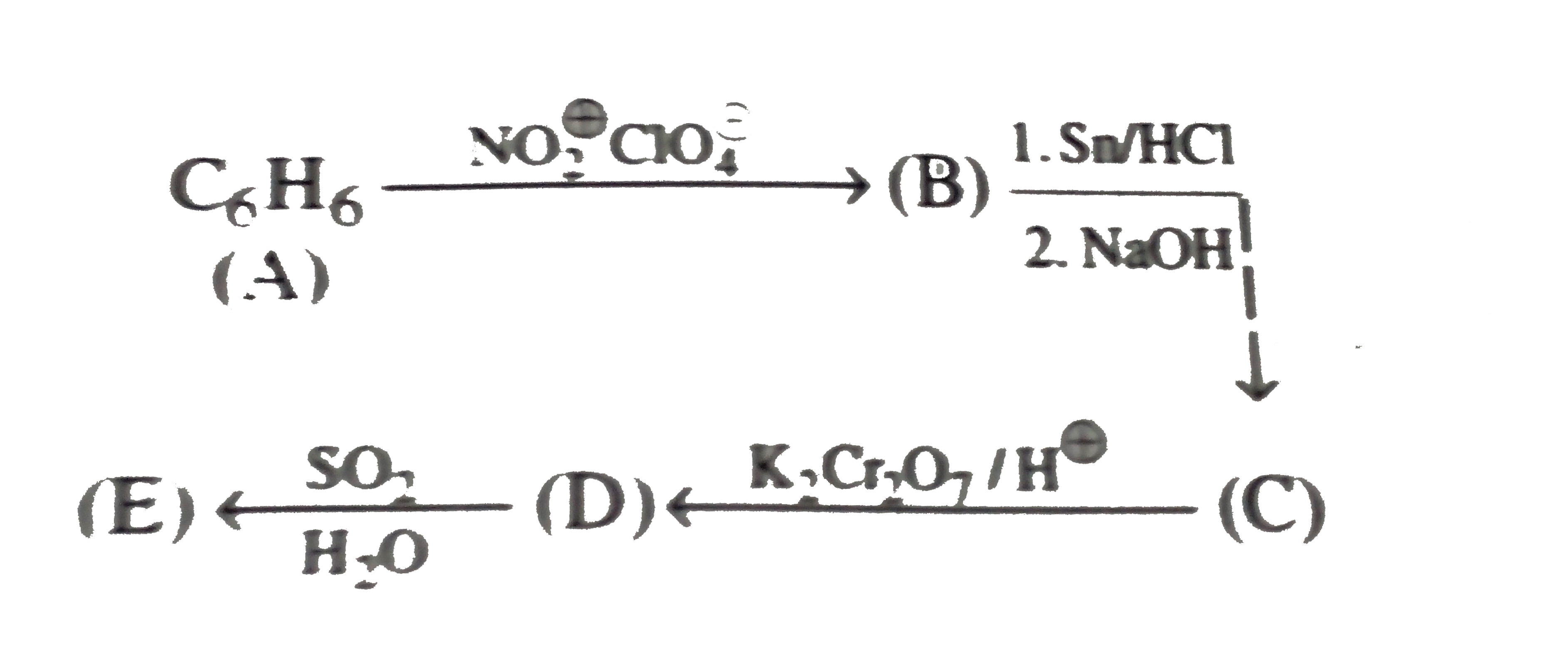Identify the compounds A, B and C :
(i) C6H5COOHPCl5−−→AH2−Pd/BaSO4−−−−−−−−−→BKCN alc−−−−→distilC
(ii) H−C≡C−HH2O−−−−−−−−−−−−−→ dil H2SO4+HgSO4AH2−−→NiB140∘C−−−−−−→concH2SO4C
To solve the problem, we will identify the compounds A, B, and C step by step for both parts of the question.
Part (i)
1. Starting Compound: The starting compound is Benzoic acid, which has the formula C6H5COOH.
2. Reaction with PCl5:
- When benzoic acid reacts with phosphorus pentachloride (PCl5), it undergoes a substitution reaction where the hydroxyl group (-OH) of the carboxylic acid is replaced by a chlorine atom.
- This reaction produces Benzoic chloride (A), which has the formula C6H5COCl.
3. Reaction with H2 and Pd/BaSO4:
- Benzoic chloride (A) is then treated with hydrogen gas in the presence of a palladium catalyst on barium sulfate (Pd/BaSO4), which is a method of partial hydrogenation.
- This reaction reduces the carbonyl group (C=O) to a formyl group (aldehyde), yielding Benzaldehyde (B), which has the formula C6H5CHO.
4. Reaction with KCN (alcoholic, distillation):
- Benzaldehyde (B) reacts with potassium cyanide (KCN) in an alcoholic medium, leading to the formation of a cyanohydrin.
- The product formed is Benzoinitrile (C), which has the formula C6H5CH(OH)CN.
Summary for Part (i):
- A: Benzoic chloride C6H5COCl
- B: Benzaldehyde C6H5CHO
- C: Benzoinitrile C6H5CH(OH)CN
Part (ii)
1. Starting Compound: The starting compound is Ethyne (acetylene), which has the formula HC≡CH.
2. Reaction with H2O (dil H2SO4 + HgSO4):
- Ethyne reacts with water in the presence of dilute sulfuric acid and mercuric sulfate (HgSO4) to undergo hydration.
- This reaction produces Acetaldehyde (A), which has the formula CH3CHO.
3. Reaction with Ni (hydrogenation):
- Acetaldehyde (A) is then treated with hydrogen gas in the presence of a nickel catalyst, which reduces the aldehyde to an alcohol.
- The product formed is Ethanol (B), which has the formula CH3CH2OH.
4. Reaction with concentrated H2SO4 at 140°C:
- Ethanol (B) reacts with concentrated sulfuric acid at elevated temperature (140°C), leading to dehydration.
- This reaction produces Diethyl ether (C), which has the formula CH3CH2OCH2CH3.
Summary for Part (ii):
- A: Acetaldehyde CH3CHO
- B: Ethanol CH3CH2OH
- C: Diethyl ether CH3CH2OCH2CH3
Final Summary of Compounds:
- Part (i):
- A: Benzoic chloride C6H5COCl
- B: Benzaldehyde C6H5CHO
- C: Benzoinitrile C6H5CH(OH)CN
- Part (ii):
- A: Acetaldehyde CH3CHO
- B: Ethanol CH3CH2OH
- C: Diethyl ether CH3CH2OCH2CH3
1. Starting Compound: The starting compound is Benzoic acid, which has the formula C6H5COOH.
2. Reaction with PCl5:
- When benzoic acid reacts with phosphorus pentachloride (PCl5), it undergoes a substitution reaction where the hydroxyl group (-OH) of the carboxylic acid is replaced by a chlorine atom.
- This reaction produces Benzoic chloride (A), which has the formula C6H5COCl.
- Benzoic chloride (A) is then treated with hydrogen gas in the presence of a palladium catalyst on barium sulfate (Pd/BaSO4), which is a method of partial hydrogenation.
- This reaction reduces the carbonyl group (C=O) to a formyl group (aldehyde), yielding Benzaldehyde (B), which has the formula C6H5CHO.
- Benzaldehyde (B) reacts with potassium cyanide (KCN) in an alcoholic medium, leading to the formation of a cyanohydrin.
- The product formed is Benzoinitrile (C), which has the formula C6H5CH(OH)CN.
- A: Benzoic chloride C6H5COCl
- B: Benzaldehyde C6H5CHO
- C: Benzoinitrile C6H5CH(OH)CN
1. Starting Compound: The starting compound is Ethyne (acetylene), which has the formula HC≡CH.
- Ethyne reacts with water in the presence of dilute sulfuric acid and mercuric sulfate (HgSO4) to undergo hydration.
- This reaction produces Acetaldehyde (A), which has the formula CH3CHO.
- Acetaldehyde (A) is then treated with hydrogen gas in the presence of a nickel catalyst, which reduces the aldehyde to an alcohol.
- The product formed is Ethanol (B), which has the formula CH3CH2OH.
- Ethanol (B) reacts with concentrated sulfuric acid at elevated temperature (140°C), leading to dehydration.
- This reaction produces Diethyl ether (C), which has the formula CH3CH2OCH2CH3.
- A: Acetaldehyde CH3CHO
- B: Ethanol CH3CH2OH
- C: Diethyl ether CH3CH2OCH2CH3
- Part (i):
- A: Benzoic chloride C6H5COCl
- B: Benzaldehyde C6H5CHO
- C: Benzoinitrile C6H5CH(OH)CN
- A: Acetaldehyde CH3CHO
- B: Ethanol CH3CH2OH
- C: Diethyl ether CH3CH2OCH2CH3
Topper's Solved these Questions
Similar Questions
Knowledge Check
CH3CH2CH2OHconc. H2SO4−−−−−−−−→170∘CACl2−−−→500∘CB.
A and B. areAA=CH3CH2CH3,B=CH3CH2CH2ClBA=CH3CH=CH2,B=CH2ClCH=CH2CA=CH2=CH2,B=CH3CH2ClDA=CH3CH2CH3,B=CH3CH=CH2
Identify the following compounds :
i. C6H6(A) 2H2SO4−−−−→ (B) 1.NaOH,540K−−−−−−−−−→2.HCI (C)
ii.
View SolutionIdentify the compounds A,B and C :
(a) C2H5OHPCl5−−→AKCN−−→BH3O+−−−→C2H5COOHNH3−−−−−→ΔC
(b) C6H5COOHSOCl2−−−→ANH3−−→BBr2/KOH−−−−−−→C
View SolutionCH≡CHH2O−−−−−−−−−→HgSO4/H2SO4[A]LiAlH4/H−−−−−−→[B]H2SO4(conc.)−−−−−−−−−→443K[C]
View SolutionH3C−C≡CHH2O,H4SO4−−−−−−−→HgSO4intermediateA→productB
View SolutionC6H5−C≡C−CH3HgSO4−−−→H2SO4A
View SolutionRCOOHPCl5−−→AH2−−−−→CalalystBH2−−−−→CatalystCPBr3−−→DKCN−−→EH+−−→H2OF
View SolutionCH3−CH=CH2HBr−−−−→Peroxide[A]KOH(aq)−−−−−−→[B]H2SO4(conc.)−−−−−−−−−→443K[C]
View Solution
